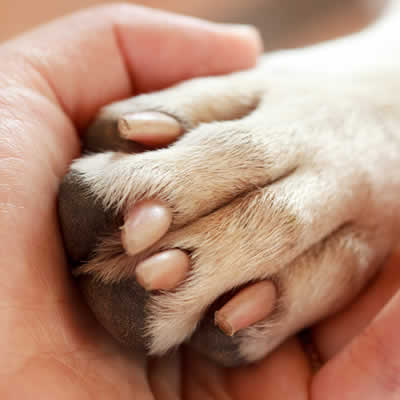Home » Blog » DIY Dog Grooming Tips & Tricks
DIY Dog Grooming Tips & Tricks
Groom Your Dog At Home

Dog fur comes in many lengths and textures, from long to short and coarse to smooth. But no matter what kind of fur your dog has, there are several measures you can take at home to keep your dog looking its best. The same goes for care when it comes to your pet’s teeth and nails. Read on to find out tips and tricks for DIY dog grooming.
Washing Your Dog
For dog grooming, always use lukewarm water. According to Jocelyn Robles, a professional groomer at Holiday House Pet Resort, water that is too cold or hot can create a negative atmosphere. Furthermore, extremely hot water can lead to rashes. To avoid this, spray your hand until the water reaches the desired temperature.
1. Shampoo
Shampoo is an important dog-grooming tool. Dogs’ skin has a different pH balance than human skin, so invest in dog shampoo rather than using your own. Look for one that matches your dog’s age (puppy shampoo, for example) and needs. If your dog has sensitive skin, consult your vet before making a shampoo choice. Your vet can also provide advice on medicated shampoo.
2. Massage It In
Dog grooming involves much more than simply letting shampoo soak in the dog’s fur. After applying it, agitate the shampoo. This will encase the dirt, which in turn will wash off. Massage each section of the dog’s fur for 3 to 5 minutes.
Start with your dog’s paws and legs and slowly work your way up their body. Clean your dog’s face and sensitive areas with a cotton ball to avoid getting shampoo or soap in their eyes. These substances can lead to eye infection or irritation.
Don’t neglect to wash behind your dog’s ears. Tilt your dog’s head downwards and cup around the ears to keep water out of them.
3. Thorough Rinsing
After your dog is shampooed, wash off in the opposite order. Try to wash your dog with water at least twice to prevent dried shampoo from sticking around. The WaterComb™ spray of the Pet Wand PRO penetrates even the thickest fur and quickly reaches dirt and shampoo for a deep and thorough clean.
4. Dry Your Pup
Once the dog is clean, try to get your dog’s fur as dry as possible. Have plenty of towels at the ready. Unless it’s in the hands of an expert, a blow dryer is not recommended. It is difficult to regulate the temperature, meaning burns are possible. Additionally, some dogs are frightened of the noise, which can turn them off from bathing completely.
Bathe Once a Month
Bathing roughly once a month is sufficient for most dogs. Dogs groom themselves naturally, so bathing beyond that is unnecessary. Additionally, bathing too much can remove some of the fur’s natural oil and create skin irritation. The best bathing schedule is determined by your dog’s activity level and breed, so some research on your particular pet to figure out the best DIY dog-grooming schedule.
Paw Care
A good bath will clean the tops of your dog’s feet, but the nails require care as well. A great dog-grooming tip is to listen to your dog walk around; if you can hear the dog’s nails tap on the floor, they’re too long. Overly long nails can get caught on objects and even tear off. To prevent this, your dog’s nails should be trimmed regularly so they are short and even.
It’s important to avoid cutting the quick, which is the nerve and blood vessel that runs through the nail. To learn proper nail cutting technique, consult your vet or groomer.
The tufts of hair in between the paw pads also require care. When this fur is untrimmed, it can collect dirt, tar, and small stones. During the winter, ice can also get stuck in this fur. Matting is another issue. When trimming this fur, take care to not cut your dog’s paws.
Brushing Your Dog
Professionals suggest brushing your dog’s fur at least 3 times a week, depending on their coat and size. You should also brush your dog before and after giving them a bath. This will ensure your dog’s coat remains clean, shiny, and free of tangles.
Dogs with double coats, like Labradors and German Shepherds, should also be brushed while they are being shampooed. This will remove some of the excess undercoat hair and reduce shedding. All other breeds should be as dry as possible before brushing begins.
If your dog has matted fur, brushing can be a painful and unpleasant experience for them. Take them to a professional groomer instead of trying to work the mats out yourself. Once they are cleared, you can begin your regular brushing routine.
Ear Care
When it comes to dog grooming, the ears are important as well. Owners should clean not only the outside of dogs’ ears, but the inside as well. With that said, note that cleaning the ears too much can actually lead to infection.
Once weekly, check your pet’s ears. There should be no foul odor, no dirt, and no redness. Doing this every week can also help you quickly figure out if there is something medically wrong with your dog. A vet or groomer can provide specific ear-cleaning instructions for your particular dog.
Dental Care
Ideally, you should brush your dog’s teeth every day, preferably at a time the dog is relaxed. Doing so can prevent the buildup of plaque and future gum problems, just like in humans. There are many methods of brushing your dog’s teeth, including toothpaste and toothbrush, finger brushes, and food additives.
Looking for a good DIY dog grooming tool? Try the Pet Wand PRO, which is perfect for outdoor bathing or cleaning your dog in the shower.
